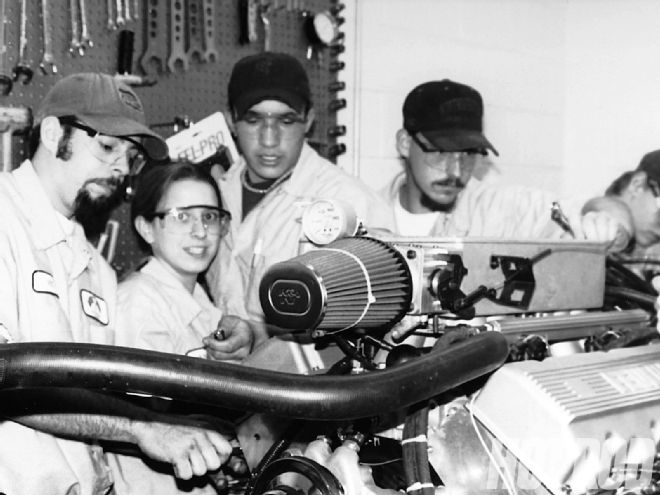
When Northwestern College instructor Bill Sergent snapped the throttle, the high-torque 502 seemed as if it would rip its moorings from the dyno cart. But this would not be the first time something sounded great but didn't perform. In Part One ("Lean, Mean, and Clean," Feb. '98) of this buildup, the big-block suffered from fuel reversion into the plenum, lifters that failed to pump up, and, to rub salt in the gouge, a broken piston and a scored cylinder wall.
Since the engine tuning was done while in the presence of fuel reversion, all the values were deemed invalid. For Part Two, the fuel map in the ACCEL ECU was reformatted using a program that calculates a base fuel table according to the data it receives. Hence, the linear oxygen sensor was set to correct out to an air/fuel ratio of 13.0:1 at full load, and the timing was set at 21 degrees total.
The motor sounded strong, but tension grew as the step test from 2,000 to 4,500 rpm progressed. Bill White, the instructor in charge of engine assembly, calmly tore the paper from the printer and read the numbers aloud: 603 lb-ft at 2,000 rpm. Uh-oh. A good start, but almost 100 lb-ft shy of the goal. It was going to be a long night.
To recap the situation, let's review the occurrences of Part One and what was done to correct them.
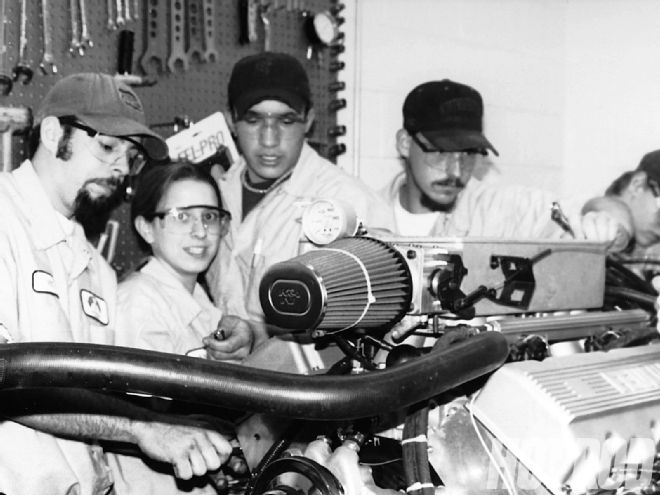 The students performed a compression test as preventive maintenance. All cylinders were at 210 psi.
The students performed a compression test as preventive maintenance. All cylinders were at 210 psi.
Fuel Reversion
Tuned intake-manifold designs take advantage of inertial supercharging by means of organ-pipe resonance and Hemholtz ram and resonant effects. This leaves them very susceptible to valve-timing events. Because time was of the essence in Part One, the students chose what they believed to be hardly used hydraulic roller lifters (a new set was a week's wait). Obviously, the lifters were bleeding down at different rates, which created intake reversion and noise. Further, each cylinder operated with varying valve events, and that caused havoc when the manifold began to resonate. The ACCEL Stealth is tuned to begin resonating at 2,000 rpm, and since the lifter bleed down caused the valve to shut prematurely, the fuel bounced back up the tuned runner when it collided with the closed intake valve. New GM lifters solved the problem.
Broken Piston
One of the benefits of the Keith Black hypereutectic piston is its ability to accommodate press-fit or full-floating wristpins. The floating pin required honing the small end of the GM connecting rods, so they were press fitted instead. Unfortunately, the small end of one connecting rod was already slightly oversize in anticipation of the full-floating application. It was inadver-tently mixed in with the seven press-fit rods and installed accordingly.
The honing procedure that had been terminated at midpoint had gone unnoticed by the students when they had heated the rod and slid the pin into place. After a short time on the dyno, cylinder pressure caused the pin to walk out and cock in the bore. Eventually, the piston broke and scored the cylinder wall. In preparation for Part Two, the students sleeved the block, installed a new piston of the same weight, and introduced full-floating pins throughout.
Searching for Mr. Torquebar
Knowing the engine had more to give, the team began tweaking the fuel and timing tables. The linear oxygen sensor was pegged at full-correction lean, subtracting 17.8-percent fuel from the matrix to achieve an air/fuel (A/F) ratio of 13.0:1. They leaned out the map by 10 percent, still revealing a fuel correction of the same value. Consequently, a net A/F ratio of 10.53:1 yielded a brake-specific fuel consumption (BSFC) in the 0.42-0.44 range. This was extraordinary. The 502 was using about the same amount of fuel as a small-block, and the mixture was overly rich to boot. Further tuning had the correction at + or - 1 percent and the BSFC values down to 0.39. With the leaner calibration, however, the engine began to enter hysteresis of knock (the zone attended by a closed-loop timing-control system to cool down the combustion chamber and quell detonation). The quenching effect of the previously overrich A/F ratio had cooled the combustion chamber. This was noted by the ECU, which identifies knock retard on the screen of the timing map. The timing matrix had 21 degrees total advance. It was scaled with a maximum of 25 degrees at light load and pulled back to 21 degrees by three-quarters load and at 2,000 rpm. NOTE: The quick-burn characteristics and the centrally located spark plug in the Feuling cylinder head requires meager spark lead.
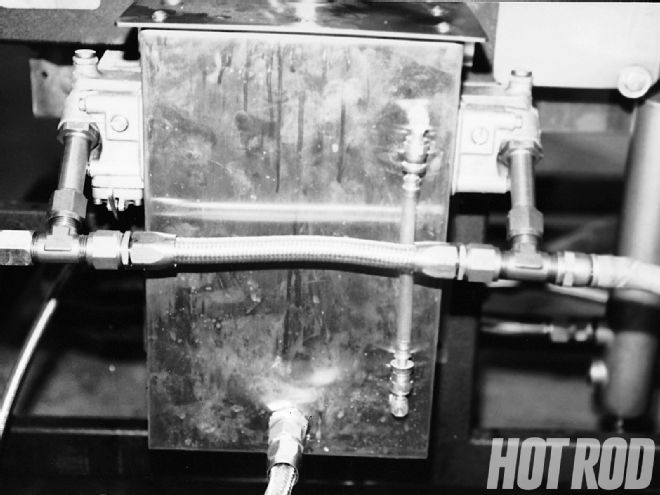 Electronic fuel-injection systems pump more fuel than they actually use. To measure BSFC with this configuration, the students designed and built a device that reads the amount of fuel pumped, as well as the amount of fuel returned, to the tank.
Electronic fuel-injection systems pump more fuel than they actually use. To measure BSFC with this configuration, the students designed and built a device that reads the amount of fuel pumped, as well as the amount of fuel returned, to the tank.
A mechanical-advance distributor is referenced only to rpm, but an electronic spark-timing ECU alters spark lead as a function of load and engine speed. Entering the hysteresis of knock zone is detrimental to power because the computer removes timing to control the abnormal combustion. The students made another pull. The leaner mixtures picked up an average of 10 lb-ft with a peak gain of nearly 25 lb-ft. The knock control system retarded the timing 12 degrees, leaving a total advance of 9 degrees. The Feuling cylinder head was designed to run 11.0:1 static CR with a 454ci engine, so the huge 4.500-inch bore, 87-octane fuel, and 12.3:1 compression really teased the octane tolerance.
The dyno cell was full of discussion. Some of the students believed that they'd pushed the envelope too far and would need a minimum of 89-octane fuel. This was unacceptable, of course, so they replaced the coolant with Evans NPG coolant along with a 7-pound pressure cap. The Evans formula is waterless and has a boiling point of 369 degrees F at zero pressure. The NPG boils at higher temperatures and recondenses into liquid sooner. In theory, these features would help limit abnormal combustion.
It worked. With the Evans coolant, the knock retard system pulled timing back only 0 to 1 degree, and the students picked up approximately 15 lb-ft of torque. Then they trimmed another 0.5 degree from the timing matrix to eliminate detonation.
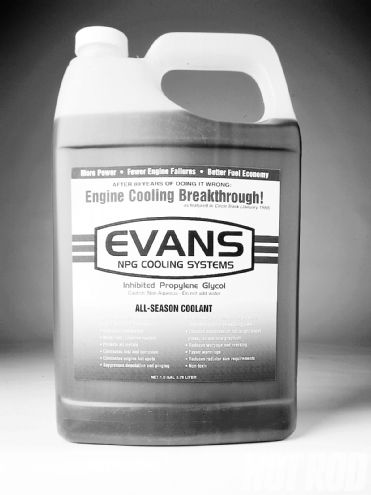 The Evans NPG coolant helped quench detonation and allowed the leaner 13.2:1 air/fuel ratio the team required.
The Evans NPG coolant helped quench detonation and allowed the leaner 13.2:1 air/fuel ratio the team required.
The students were at 628 lb-ft... and running out of magic dust. Having thrashed this mule unmercifully, they let it cool for one hour and iced down the intake plenum in the meantime. As there is no vaporization of fuel taking place to draw the heat out of the casting, dry-flow manifold designs are very susceptible to thermal transfer. The ECU revealed that the air in the plenum was more than 180 degrees F-way too hot to make power. A law of physics states that for every 10 degrees F change in air temperature, power is affected by 1 percent. Even if they were successful at getting the plenum temperature down to 100 degrees F, they still wouldn't be able to quantify how much heat would be picked up by the air as it traveled the 14 1/2-inch runners.
After the cooldown, they found another 10 lb-ft. The students noticed that a few of the cylinders had a higher exhaust-gas temperature (EGT) than others, something that could be tempered with the ACCEL Variable Injector Controller (VIC). The VIC affords the ability to alter the injector pulse width on a per-cylinder basis, so the students dialed in 2-percent additional fuel and went for it. The temperature of the air in the intake manifold was 150 degrees F, but they found an additional 15 lb-ft nonetheless, bringing the peak to 643 lb-ft. Repeated pulls and tuning never bettered that value. Working under the assumption that the engine was starving for air, they decided to swap intake manifolds.
The Superam
Testing with the Stealth (see Part One for flow data) indicated a substantial flow loss due to runner length and a mismatch at the entry of the cylinder head. The Feuling cylinder head has a substantially larger area at the entry to the intake port, while the Stealth is much smaller. Since one of the students' mandates was strictly bolt-on parts, the ACCEL manifold was not radiused to improve flow into the cylinder head.
On the other hand, the ACCEL Superam has larger runners that match the cylinder head better, but they are substantially shorter than those of the Stealth. The students didn't have any flow numbers for the Superam but felt it would be worthwhile if it could provide a gain that would outweigh the tuning advantages of the Stealth. The best number with the larger, shorter runners was 50 lb-ft less peak torque and lower average numbers.
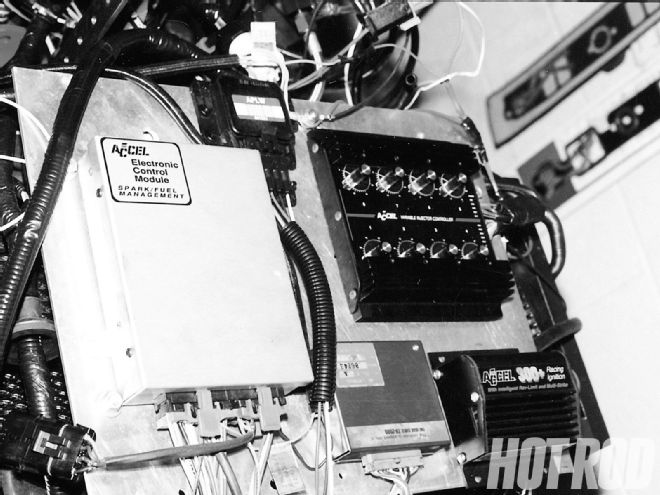 ACCEL's advanced electronics were major contributors to the success of the engine.
ACCEL's advanced electronics were major contributors to the success of the engine.
Did They Really Miss the Mark?
The students' best effort yielded the following numbers with 19-degrees total timing and a 13.2:1 A/F ratio:
RPM Torque (lb-ft) HP BSFC 2,000 643 249 0.35 2,500 637 303 0.37 3,000 599 342 0.36 3,500 532 367 0.38 4,000 501 381 0.37 4,500 452 388 0.38
Since they were well below their goal of 700 lb-ft, it would be easy to feel that the experiment fell short of the mark. According to the numbers, you would be correct. Looking beyond that, they did set some very exciting new standards with the 502.
1) The cylinder heads were fitted with 1.850-inch intake valves and 1.435-inch exhaust valves. In performance applications, most port designs require an intake valve 0.52 times the bore size; in this case, a valve 2.30 inches in diameter. The advanced airflow technology of the Feuling head accomplished this with a valve that was 20-percent smaller (0.41 times the bore).
2) Due to the efficiency of the combustion chambers and the Evans coolant, this level of power could be supported with a 30-lb/hr fuel injector and a BSFC of 0.35. With a BSFC value of approximately 0.55 on a production big-block Chevy, fuel consumption was shaved by 37 percent.
3) Considering the 12.3:1 static compression ratio, 87-octane fuel, and a 13.2:1 A/F ratio, the cylinder heads, coolant, and Keith Black pistons set standards for octane tolerance.
4) The students felt confident that their goal would have been attained had they ported the cylinder heads, Extrude Honed the intake manifold, and radiused the inlets for better airflow.
5) The engine remained emissions-legal with less than 150 PPM HC and 0.9 CO, without catalytic converters.
6) With nearly 650 lb-ft available at 2,000 rpm on 87-octane, think of what a great tow-vehicle engine this would make.
What Could Have Been Done Differently?
The Feuling cylinder head and ACCEL intake manifold are designed as a bolt-on package for engines that displace 454 ci or less. The students made the typical bigger-is-better mistake. From the outset, they felt that the 502 might be pushing it, but the wild popularity of this particular crate engine made them try it anyway. There wasn't enough time to modify the dyno hat to accept the ACCEL throttle body, and, due to the large displacement of our engine, peak torque was calculated at approximately 75-percent volumetric efficiency. This was also evident by the drop in torque with the Superam manifold. Further, the tuning effect of the Stealth manifold was not sufficient to overcome the increase in displacement.
A thermal barrier coating on the bottom of the intake manifold would limit heat transfer-as would coating the pistons and cylinder heads with a ceramic formula-to increase effi-ciency and power production. In the future, this 502 will try the Stealth manifold with the runner extensions removed to increase airflow while decreasing runner length. Also in the works: a 410-420ci big-block using these same (502) components. With what the students know now, they are confident that an engine of this displacement will easily surpass the 700lb-ft mark! We'll be back with a high-deck, short stroke-long connecting-rod small-cube big-block that'll make friends and influence people.
Wishful Thinking
When you build an engine, it becomes your creation. At times, I believe that it even becomes a personal issue, not just a by-product of your efforts. I dwell on what went wrong, instead of what is right. I can take the long hours on the dyno; it is the disappointment that I cannot stomach. You must learn to limit the disappointment through knowledge.
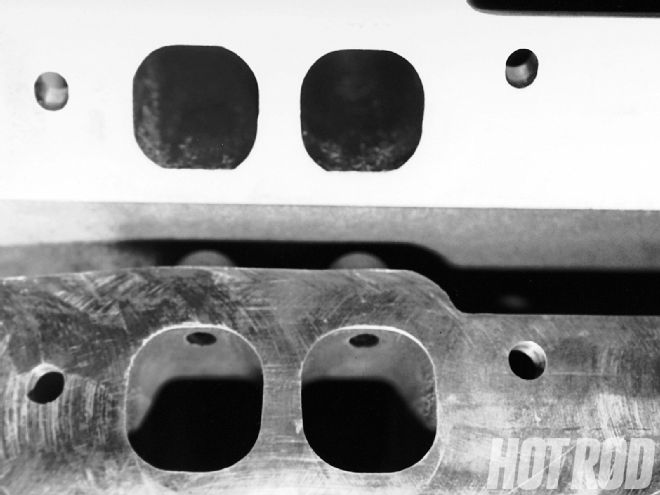 The difference between the intake ports of the ACCEL Stealth (top) and the Superam are readily apparent.
The difference between the intake ports of the ACCEL Stealth (top) and the Superam are readily apparent.
The key to successful engine building is a system's approach: A combination of the properly matched parts and cylinder heads and induction tailored to displacement. Considering the demand to function beyond their design parameters, Jim Feuling's cylinder heads and ACCEL's Stealth manifold performed admirably. Working under the assumption that only 75-percent volumetric efficiency was accomplished (VE), then the displacement of our big-block in terms of effective cylinder fill was only 377 ci. Considering that airflow in an engine is scaled against piston velocity, at 2,000 rpm this 4.00-inch stroke engine had a mean piston velocity of 1,333 feet per minute (average piston velocity is calculated: feet per minute = stroke x rpm/6).
It is an amazing accomplishment to build sufficient brake mean effective cylinder pressure to create that amount of torque. Now factor in the 502's 1.53:1 stroke-to-rod ratio, which is not ideal for an engine with a small squish area. Though lower numerical stroke/rod ratios increase instantaneous piston velocity, they limit the amount of time the piston dwells at TDC, keeping the combustion-chamber volume small as the flame front starts to expand. To my way of thinking, the Feuling heads and ACCEL intake would work even better with a higher stroke/rod ratio, thereby allowing the flame front to expand in a more quenched region. The extremely high velocities of the Feuling intake port along with the resonance tuning of the ACCEL manifold can afford to trade some piston velocity for longer TDC time and lessened frictional losses through piston side loading. -RTB
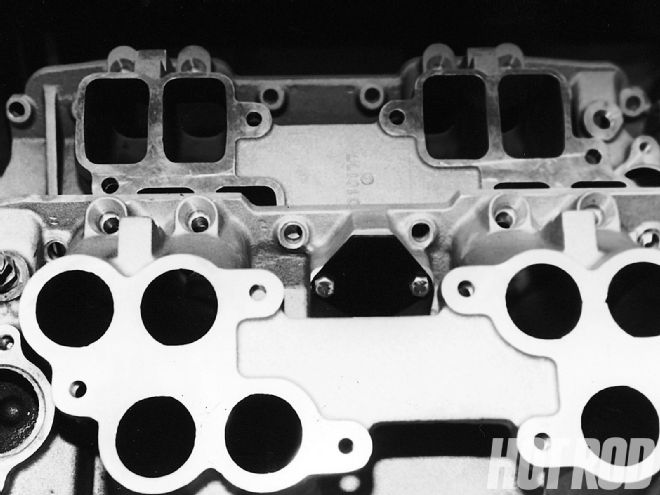 The Stealth baseplate features round ports; the Superam uses a rectangular design that tapers to an oval shape at the cylinder head.
The Stealth baseplate features round ports; the Superam uses a rectangular design that tapers to an oval shape at the cylinder head.